Are DWDM wavelengths colorful light?
What are the wavelengths of Regular light?
DWDM optical wavelength and Regular optical wavelength are both used in optical communication, and they are both invisible to the naked eye.
Table of Contents
ToggleWhich light Wavelengths are Invisible to the Naked Eye?
As shown in the figure below, the visible light range is between 380nm and 780nm. It is the light that we can see with our naked eyes, such as rainbows, etc. Other wavelengths such as X-rays, ultraviolet, infrared, and microwaves are invisible to the human eye.

Optical communication refers to fiber optic communication, which can be used to transmit optical signals in optical fibers. Optical communication is widely used in OTN, SDH, IP, and other networks.
The optical wavelength range of optical communication is 850nm~1650nm, which is located in the near-infrared region, and the light in this optical wavelength range is invisible light.
DWDM optical wavelength and Regular optical wavelength are used for optical communication, so they are also invisible light.
Where do DWDM and Regular Optical Wavelengths Fall on the Spectrum?
According to ITU-T, the optical wavelength of optical communication is divided into 850 band, O band, E band, S band, C band, L band, and U band.
- The 850nm band is also known as the first window.
- The O-band is also known as the second window (1310nm).
- The C-band is also known as the third window (1550nm).
- The L-band is also known as the fourth window.
- The E-band is also known as the fifth window.
- The S and U bands are undefined.
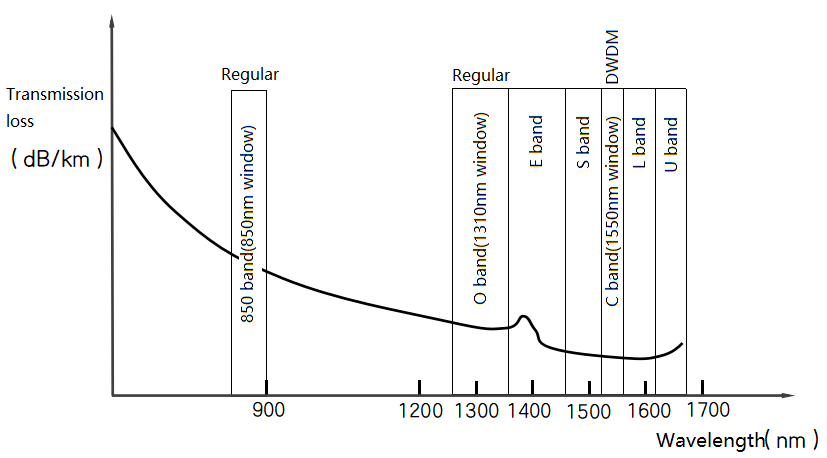
Currently, optical communication mainly uses wavelengths in the 850nm, O-band (1310nm), C-band (1550nm), and L-band ranges. DWDM optical wavelengths fall within the C-band (1550nm), while Regular optical wavelengths fall within the 850nm and 1310nm ranges.
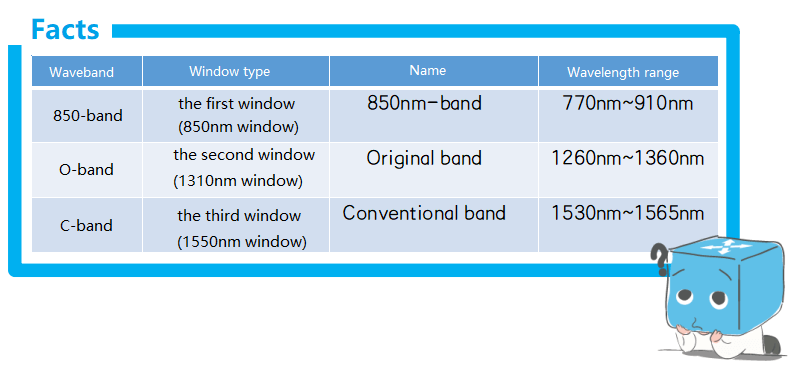
What are DWDM and Regular Optical Wavelengths?
DWDM optical wavelength refers to light in the 1550nm range with a standardized wavelength. It is typically used in OTN networks for long-distance transmission.
Regular optical wavelength refers to light in the 850nm and 1310nm ranges without a standardized wavelength. It is typically used in SDH, IP, and other networks for short-distance transmission.
To put it simply, DWDM and Regular optical wavelengths are not specific signals but rather a range of signals within a certain wavelength range. Some signals have a standardized wavelength while others do not.
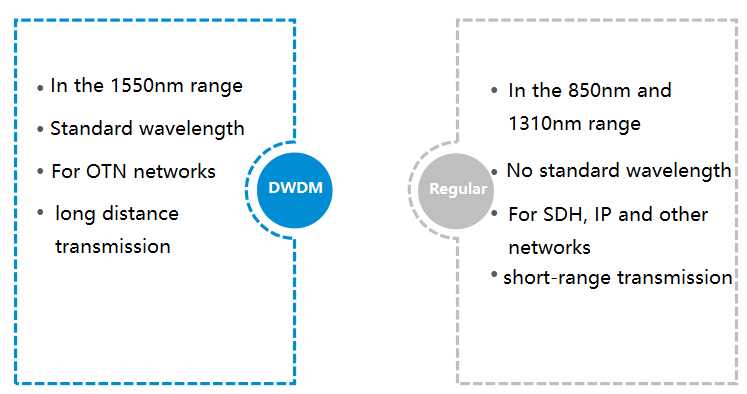
What is an optical signal with and without a standard optical wavelength?
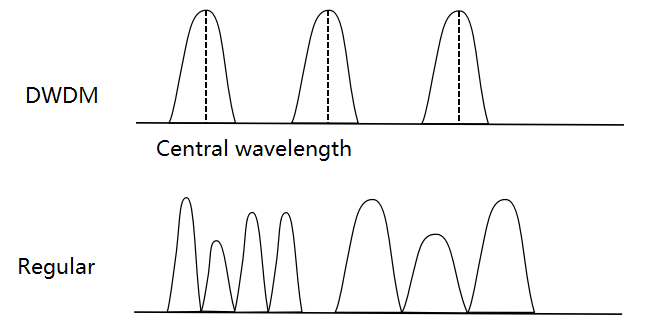
- Standard optical wavelength means that the optical signal fluctuates in a small range around some central optical wavelength and is a single optical wavelength of light.
- No standard optical wavelength means that the optical signal fluctuates within a certain range, a wider range, without a central optical wavelength.
To provide a better understanding of DWDM and Regular wavelengths, consider the following analogy:
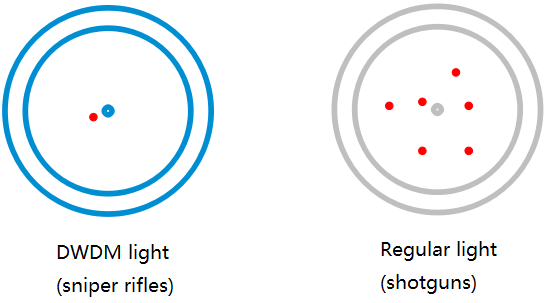
DWDM wavelengths are like sniper rifles that fire one bullet at a time, causing a single bullet hole in the target, which represents a light signal with a standard wavelength.
Regular wavelengths are like shotguns that fire multiple bullets simultaneously, causing multiple bullet holes in the target, which represent light signals without a standard wavelength.
Who Provides DWDM and Regular Wavelengths?
Optical transceiver modules provide DWDM and Regular wavelengths.
- DWDM modules transmit and receive colored light signals with a standard center wavelength.
- Regular modules transmit and receive Regular light signals without a center wavelength.
In practical network devices, SDH/IP equipment on the customer side transmits Regular light signals through Regular modules into the OTN network, where the OTN equipment converts the Regular light to DWDM light using a DWDM module for transmission.
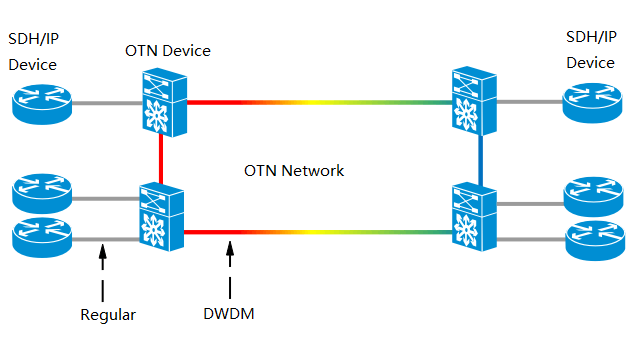
Conclusion
DWDM and Regular optical wavelengths are widely used in optical communication today, enabling efficient handling and transmission of data over optical fibers for short and long-distance scenarios in various networks, contributing to the rapid development of optical communication networks.
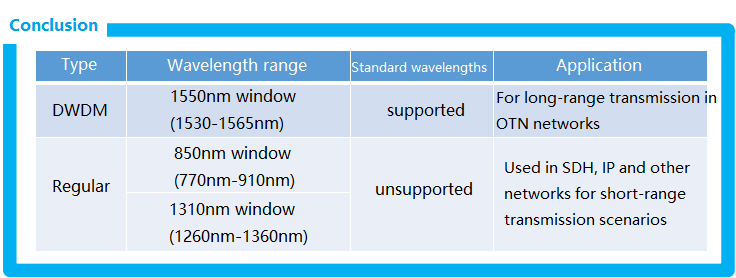
Related Products:
-
 SFP-DW10G17-40C 10G DWDM SFP+ C17 100GHz 1563.86nm 40km LC SMF DDM Transceiver Module
$155.00
SFP-DW10G17-40C 10G DWDM SFP+ C17 100GHz 1563.86nm 40km LC SMF DDM Transceiver Module
$155.00
-
 SFP-DW10G17-80C 10G DWDM SFP+ C17 100GHz 1563.86nm 80km LC SMF DDM Transceiver Module
$175.00
SFP-DW10G17-80C 10G DWDM SFP+ C17 100GHz 1563.86nm 80km LC SMF DDM Transceiver Module
$175.00
-
 SFP-DW10G17-100C 10G DWDM SFP+ C17 100GHz 1563.86nm 100km LC SMF DDM Transceiver Module
$235.00
SFP-DW10G17-100C 10G DWDM SFP+ C17 100GHz 1563.86nm 100km LC SMF DDM Transceiver Module
$235.00
-
 SFP-DW10GTU-40C 10G DWDM Tunable SFP+ 50GHz 1529.55nm~1561.83nm 40km LC SMF DDM Transceiver Module
$550.00
SFP-DW10GTU-40C 10G DWDM Tunable SFP+ 50GHz 1529.55nm~1561.83nm 40km LC SMF DDM Transceiver Module
$550.00
-
 SFP-DW10GTU-80C 10G DWDM Tunable SFP+ 50GHz 1529.55nm~1561.83nm 80km LC SMF DDM Transceiver Module
$750.00
SFP-DW10GTU-80C 10G DWDM Tunable SFP+ 50GHz 1529.55nm~1561.83nm 80km LC SMF DDM Transceiver Module
$750.00
-
 Q28-2DW1314-80C 100G DWDM QSFP28 PAM4 80km C13 C14 100GHz CS DDM Optical Transceiver
$1600.00
Q28-2DW1314-80C 100G DWDM QSFP28 PAM4 80km C13 C14 100GHz CS DDM Optical Transceiver
$1600.00
-
 Q28-DW100G15-80C Compatible 100G DWDM QSFP28 PAM4 Single Wave C15 1565.50nm 100GHz LC 80km DDM Optical Transceiver Module
$1900.00
Q28-DW100G15-80C Compatible 100G DWDM QSFP28 PAM4 Single Wave C15 1565.50nm 100GHz LC 80km DDM Optical Transceiver Module
$1900.00
-
 SFP28-DW25GT-10E 25G Tunable DWDM SFP28 C-band 48 channels 10km Optical Transceiver Module
$500.00
SFP28-DW25GT-10E 25G Tunable DWDM SFP28 C-band 48 channels 10km Optical Transceiver Module
$500.00
-
 SFP28-DW25GT-15E 25G Tunable DWDM SFP28 C-band 48 channels 15km Optical Transceiver Module
$550.00
SFP28-DW25GT-15E 25G Tunable DWDM SFP28 C-band 48 channels 15km Optical Transceiver Module
$550.00
-
 SFP28-DW25G17-40C 25G SFP28 DWDM C17 100GHz ER 40KM 1563.86nm LC SMF DDM Transceiver Module
$750.00
SFP28-DW25G17-40C 25G SFP28 DWDM C17 100GHz ER 40KM 1563.86nm LC SMF DDM Transceiver Module
$750.00
-
 EDFA 40/80 Channels DWDM C-Band Optical Booster Amplifier Maximal Output Power +20dBm Gain 15dB Saturated Optical Power +5dBm
$1139.00
EDFA 40/80 Channels DWDM C-Band Optical Booster Amplifier Maximal Output Power +20dBm Gain 15dB Saturated Optical Power +5dBm
$1139.00
-
 DWDM MUX DEMUX 8CH (C21-C28) with Express Port LC/UPC Dual Fiber LGX BOX
$500.00
DWDM MUX DEMUX 8CH (C21-C28) with Express Port LC/UPC Dual Fiber LGX BOX
$500.00
-
 EDFA 40/80 Channels DWDM C-Band Optical Line Amplifier Maximal Output Power +16dBm Gain 25dB Saturated Optical Power -9dBm
$1139.00
EDFA 40/80 Channels DWDM C-Band Optical Line Amplifier Maximal Output Power +16dBm Gain 25dB Saturated Optical Power -9dBm
$1139.00
-
 Passive DWDM Single Fiber OADM Module 1 DWDM Wavelengths (100GHz Spacing) LGX BOX
$110.00
Passive DWDM Single Fiber OADM Module 1 DWDM Wavelengths (100GHz Spacing) LGX BOX
$110.00
-
 EDFA 40/80 Channels DWDM C-Band Optical Pre-Amplifier Maximal Output Power +16dBm Gain 25dB Saturated Optical Power -9dBm
$1139.00
EDFA 40/80 Channels DWDM C-Band Optical Pre-Amplifier Maximal Output Power +16dBm Gain 25dB Saturated Optical Power -9dBm
$1139.00
-
 DWDM MUX 8CH 16 Wavlengths (TX: C43/C45/C47/C49/C51/C53/C55/C57 RX: C44/C46/C48/C50/C52/C54/C56/C58) with MON Port LC/UPC Single Fiber LGX BOX
$450.00
DWDM MUX 8CH 16 Wavlengths (TX: C43/C45/C47/C49/C51/C53/C55/C57 RX: C44/C46/C48/C50/C52/C54/C56/C58) with MON Port LC/UPC Single Fiber LGX BOX
$450.00
-
 DWDM MUX DEMUX 16CH (C21-C36) with Monitor Port LC/UPC Dual Fiber 1U Rack
$800.00
DWDM MUX DEMUX 16CH (C21-C36) with Monitor Port LC/UPC Dual Fiber 1U Rack
$800.00
-
 DWDM MUX DEMUX 50GHZ 96CH (C15-C62) LC/UPC Dual Fiber 2U Rack
$6000.00
DWDM MUX DEMUX 50GHZ 96CH (C15-C62) LC/UPC Dual Fiber 2U Rack
$6000.00


















